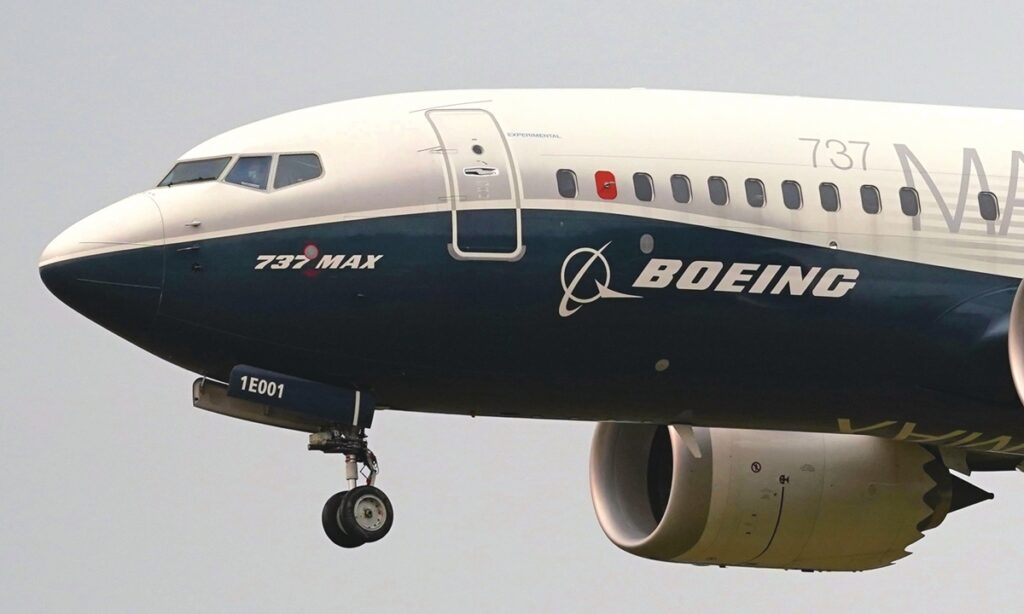As the US aerospace giant Boeing comes back into the spotlight, so does the US manufacturing sector. However, there are many man-made obstacles that stand in the way of a US manufacturing revival.
The US Federal Aviation Administration (FAA) on Saturday ordered the temporary grounding of some Boeing 737 MAX 9 aircraft operated by US airlines or in US territory. The order was issued following a report of “an in-flight departure of a mid-cabin doorplug, which resulted in a rapid decompression” on an Alaska Airlines flight departing from Portland, Oregon, as reported by NBC News.
NBC said no serious injuries were reported on the flight, which turned back and landed safely at Portland International Airport on Saturday evening. However, this does not necessarily mean Boeing can achieve a “soft landing” from this mid-air accident.
The cause of the accident is still under investigation. However, based on the current situation, including the FAA’s decision to ground some Boeing 737 Max 9 airplanes, Boeing may face significant losses.
In the third quarter, Boeing reported a loss of $1.64 billion due to a decrease in deliveries of its popular but problem-ridden 737 MAX airliners. According to the Associated Press, Boeing’s long slide began with two fatal crashes involving the 737 MAX in late 2018 and early 2019. Since then, the company has mostly operated at a loss. The latest accident may cause another crisis for Boeing.
Boeing is one of the largest aerospace companies in the world and a leading US exporter. As the core of the industry chain of the US aviation sector, Boeing holds a pivotal position in the American manufacturing industry. Its business performance in the global market is, to some extent, a barometer of US manufacturing. Boeing’s current predicament reflects an overall decline in the US manufacturing sector.
Activity in the US manufacturing sector contracted for the 14th consecutive month in December. As reported by Reuters, The Institute for Supply Management stated that its manufacturing purchasing managers’ index increased to 47.4 in December. “That is the longest such stretch since the period from August 2000 to January 2002,” the report said.
The US government is spending lavishly to revive manufacturing, but the country still has a long way to go before achieving its goals. In recent years, the government’s intervention in the economy has been strengthened. The US imposed trade remedy measures on imports and used economic security as an excuse to unjustly suppress foreign enterprises, especially Chinese high-tech companies.
Growing protectionism is raising concerns about the future of globalization. For many technology and innovation-intensive industries, such as the aerospace sector, the costs and risks of severing global supply chains are substantial. The US government’s intervention has failed to boost the economy. Instead, it has become a drag on US manufacturers.
There are deep-seated problems behind the decline of the US manufacturing sector, which is why government intervention is ineffective. For instance, US government subsidies for the manufacturing industry may increase investment in the short term, but they have not translated into higher workers’ wages. This has resulted in a shortage of qualified workers, making it challenging for manufacturers to find and retain skilled employees.
Why are manufacturers so slow to accept new technology? The US economy is undergoing deindustrialization, with a significant shift in labor toward the services industry. If the US wants to reverse this process, it must address all economic factors, including labor, in order to revive manufacturing.
Boeing’s crisis is likely to further deepen, which is undoubtedly bad news for the US manufacturing sector. After 14 months of contraction, the US manufacturing industry is accumulating risks, weakening the economic recovery in the US. Hopefully, US political elites can help defuse the risks rather than worsen them with stubborn geopolitical thinking.
